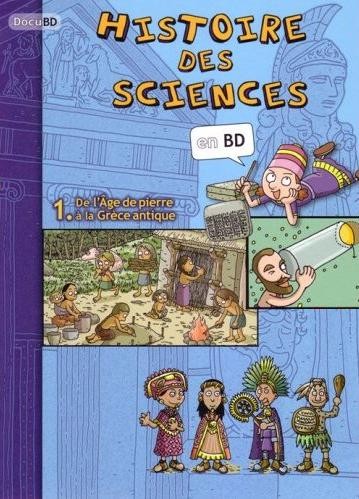Science Literacy Week may have come and gone, but the OISE Library has several new graphic novels — including titles in both English and French — that will help to continue the conversation. Eager readers and keen scientists alike will enjoy learning about science and scientific history through these engaging comics, which are best suited for middle and high school readers.
Evolution: The Story of Life on Earth
In this “whirlwind tour” of the history of evolution, the alien scientist Bloort-183 teaches readers about how organisms, including humans, have evolved into the forms we see today. Since Bloort has to explain earthly evolution to fellow aliens from the planet Glargal, he takes the time to unpack fundamental concepts — such as the Cambrian explosion, natural selection, and symbiosis — in clear detail. Students will be amazed to learn how far today’s species have evolved from the very first cells.
Primates: The Fearless Science of Jane Goodall, Dian Fossey, and Biruté Galdikas
Join the young Jane Goodall, Dian Fossey and Biruté Galdikas during their early forays into primate science. These women pioneers brought the world unprecedented insights into the lives of some of humanity’s closest animal relatives, and paved the way for a new way of doing research by studying animals while living with them as unobtrusively as possible. Along their journey, they also had to face hard questions about Western science’s appropriation of indigenous knowledge. This book will be useful in biology classrooms, as well as for discussions of ethics in science.
Dinosaurs 1: In the Beginning…
This humorous and information-packed volume transports students back to the days of the dinosaurs. Readers will love the many profiles of dinosaur species, including the geographical areas where various species lived, their sizes and diets, and the meanings of their scientific names. The book also tackles topics such as “The disappearance of the dinosaurs,” “At home with the pterosaurs,” and “How are fossils formed?” Short but informative chapters make this book easy to digest.
L’origine de la vie: autobiologie de molécule  originelle
originelle
Meet Molécule Originelle, the protagonist of this humourous account of life in the primordial soup. Beginning from the moment when life first emerged approximately 3.8 billion years ago, the asexual Molécule Originelle speaks of loneliness and the long wait for other life to arrive on the scene. Much confusion ensues when the Molécule Originelle finds itself split in two, but with a new molecule around to bounce ideas off of, the two manage to figure out that mitosis has just occurred. Watch these cells continue to split, shift shape, and form ever more complicated organisms — and even tackle some existential questions along the way. (Please note that this book, which originally appeared as a web comic, contains some more mature sexual themes and language.)
 The Solid Truth about States of Matter: With Max Axiom, Super Scientist
The Solid Truth about States of Matter: With Max Axiom, Super Scientist
Join the friendly scientist Max Axiom, who uses a range of familiar places and objects — such as a swimming pool, a chocolate bar, and a snow cone — to explain how matter works. In particular, Max explains how transitions between states of matter take place at the level of atoms and molecules, and how these transitions affect our daily lives. This comic is a great way to introduce students to core concepts in chemistry.
Histoire des sciences en B.D. 1: de l’Âge  de pierre à la Grèce antique
de pierre à la Grèce antique
This book provides a rich introduction to the histories of science across the world, covering the ancient world from the Stone Age onward. Particularly valuable here is the authors’ attention to the diversity of ancient science, with chapters covering the ancient civilizations of Central America, South America, and Asia Minor, in addition to the better-known scientific traditions of ancient Egypt and Greece. Students will be interested to learn about early scientific communication — such as the influence of scientific traditions in Asia Minor on those in Greece — as well as topics such as the relationship between science and religion, and how scientific discoveries proceeded from everyday observations. Don’t miss the illustrated timeline of scientific milestones, which appears at the end!
